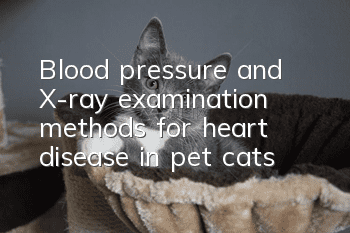Blood pressure and X-ray examination methods for heart disease in pet cats

The basic examination of a cat’s heart is to listen to the heart sounds, check the heart rate, or detect heart abnormalities based on the breathing frequency. These can detect heart abnormalities in time. Of course, detecting abnormalities is the first step, and further diagnosis is required. The condition requires the use of blood pressure measurement, radiographic examination, cardiac ultrasound examination, etc.
1. Blood pressure check
Blood pressure measurement methods are divided into direct invasive and indirect non-invasive. Direct invasive blood pressure measurement is the best method, but it is technically difficult to implement in unsedated cats, and common side effects are pain or Hematoma situation. The advantage of the non-invasive method is that it requires only slight security restrictions and is easy and convenient to operate. Non-invasive methods include auscultation, Doppler, pulse amplitude, and photoplethysmography.
All non-invasive blood pressure checking methods require the use of an inflatable tourniquet tied to the limb for measurement. The pressure of the tourniquet is measured through a sphygmomanometer or pressure sensor, and a pressure bulb is used to pressurize it. , then use the relief valve to release the pressure, and read the scale on the pressure mark, but the method of monitoring blood flow is different.
1. Auscultation: Place the stethoscope on the artery proximal to the tourniquet. When the inflation pressure gradually drops to the systolic pressure, you will hear the sound of blood flow. This is the systolic pressure, but the arterial blood flow of the animal The sound is usually small in frequency or amplitude, and the auscultation method is not suitable for cats.
2. Doppler type: Place the detector on the artery in the wrist, and use an amplifier to amplify the sound so that the operator can easily hear the sound of blood flow.
3. Pulse wave amplitude type: Because if the cuff detects a pulse, it will pressurize until the pulse disappears, and then release the pressure to measure systolic blood pressure, diastolic blood pressure, mean arterial pressure and pulse rate.
4. Photoplethysmography: Use the change in infrared attenuation to calculate arterial volume. This method was originally designed to be used on human fingers, so it can be used on cats less than 10 kg.
Photoplethysmography machines are more expensive, and the objects of use are limited. The auscultation method is difficult and difficult to operate. Therefore, the Doppler method and the pulse amplitude method are most commonly used clinically. However, the pulse amplitude method is not suitable for cats. It takes a long time to measure and the machine makes a loud inflating sound, which makes it difficult for cats to use. However, the disadvantage of the Doppler method is that the calculation and measurement of diastolic blood pressure or average pressure are not accurate. In terms of non-invasive measurement methods, it is still recommended that the "Doppler blood pressure monitor" is the best choice for blood pressure measurement.
2. X-ray diagnosis
When a cat lies on its side, under X-ray, because the spindle will rotate slightly, the chambers of the right heart will be tilted toward the head, and the chambers of the left heart will be tilted toward the tail.side. The shape of the heart is oval, and the angle drawn from the branches of the trachea to the apex of the heart will form about 45 degrees with the sternum. In cats, the angle decreases with age, possibly because the elasticity of the connective tissue with the aorta decreases. related.
The correct position range for X-ray examination of feline heart disease should be from the first rib to the first lumbar vertebra. A complete chest image has been obtained. The center of the lateral film should be aligned with the 4th to 5th intercostal space, and the anteroposterior film should be aligned with the edge of the scapula. The position of the heart is different between the left and right views. On the left view, the apex of the heart is usually too high above the sternum, and the contact area with the sternum is widened. This is often mistaken for an enlarged right heart. Therefore, we often choose to take the right side lying film; on the front view, the position of the heart may fluctuate slightly due to gravity, and the pulmonary blood vessels at the hilum are more obvious during pulmonary ventilation. The shape of the heart is round in the X-ray, and longer in the ventral and dorsal anteroposterior X-rays. Therefore, doctors usually choose one side X-ray combined with the front X-ray to help diagnose heart disease. Sometimes it is necessary to take both side X-rays. film to clearly assess the condition of the lung fields.
- A cat will die if it urinates for a few days
- Should you deworm yourself or go to a pet store?
- Are cat teasers harmful to cats?
- What should I do if my cat suffers from chronic gingivitis?
- Cat's nails are cracked with a thin layer
- Cats go crazy after eating mutton
- What does cat moss on a cat’s chin look like?
- Can cats reproduce after abdominal transmission is cured?
- What exactly is the sterilization shot for female cats?
- Can I still eat unopened cat food if it has expired?



